
Icebergs on the Ross Sea, Antarctica / Courtesy of NASA
Land Design Studio is a cross-disciplinary design consultancy in London that has been creating visitor experiences since 1992. We tell stories in cultural and commercial spaces through the integration of interior design, architecture, scenography and communication media.
Over the last 25 years working in the cultural domain, Land’s focus on the relationship between architecture, narrative and communication media has contributed to the completion of 18 lottery funded capital projects including greenfield sites and interventions within existing listed buildings working alongside architects, landscape architects and engineers. Starting with feasibility studies and masterplanning, the holistic processes is activated by extended collaboration with curatorial teams, and many other creative disciplines in order to achieve appropriate integrated solutions.
By contrast, Land has designed numerous temporary and touring exhibitions for the V&A, British Museum, NHM, IWM, the Maritime Museum and Historic Palaces, which require very different design methodologies. Educational initiatives include Centre of the Cell a science project for primary school children at Queen Marys University of London and The Sutton Life Centre which is another innovative immersive experience dedicated to teaching PSHE to different year groups.
Land has developed close associations with new media artists and media laboratories such as MIT Media Lab and Ars Electronica to help develop interfaces, immersive environments and utilise other emerging technologies for adaptation in visitor attractions and the museum domain resulting in many awards including an Interactive BAFTA, D&AD Yellow Pencil and Art Directors Club New York Gold Award.
Alongside working with cultural institutions, Land have always been comfortable working in the private sector attracting clients such as Eurostar (St Pancras departure lounge), Christies (Mayfair redevelopment), and Anschutz (British Music Experience at the O2 Greenwich). International work includes the interpretation programme for the commercially successful Gardens By the Bay Singapore, and a medicine gallery for the Miraikan in Tokyo.
As visitor experience designers we have always been fascinated by the Expo phenomenon having designed the award winning UK Expo pavilion in Japan 2005 and the highly popular £40m UAE pavilion in Milan 2015 working with Foster+ Partners. Land were also consultants for The City Being Pavilion at the Shanghai Expo 2010, and for the Mobility and UAE National pavilions at Dubai Expo 2021.
Land Design Studio has been part of the UKTI Creative Industries Taskforce and was recognised in the Creativity is GREAT campaign.
Creative Director Peter Higgins has always had a commitment to design education and the dissemination of experience design in practice, he has lectured extensively Internationally, and written numerous chapters and articles in the field. He has been an external examiner for 20 years, maintained a close relationship with Museum Studies department at Leicester University, helped initiate MA Narrative Environments at Central St Martins where he was visiting professor and has most recently been a Visiting lecturer at The Royal College of Art. In 2009 he was awarded RDI, Royal Designer for Industry.
To understand the evolution of our design practice view this video ‘The History of the Future’, this video presents our extraordinary opportunity to design the highly acclaimed Playzone at The Millennium Dome in London which opened midnight 2000. A BBC documentary team tracked the whole project over 30 months and as a starting point we have used some of this as source material and later exploited our own extensive video library to assemble a unique record of how this experience impacted on our practice over the last 20 years.
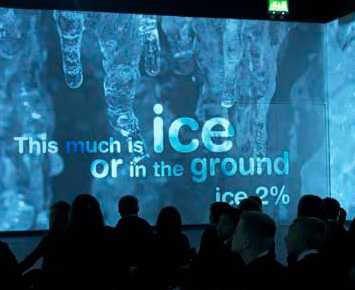
Immersive Media
Land have been exploring and developing immersive digital media for over 20 years winning many awards including an Interactive Bafta for The Famous Grouse.
Click on any of the projects below to see more.
UAE PAVILION MILAN expo 2015
Client: National Media Council, Abu Dhabi
Budget: €8m
Location: Milan, Italy
Completion: May 5, 2015
Land were appointed to undertake the complete experience design for this £40m project working with architects Foster + Partners. It was clear that the objective was for the visitor experience design to help inform the integrated architectural process resulting in an iconic architectural pavilion. With considerable involvement in previous Expo’s, the NMC set a daily target of 8,000 visitors informing extensive visitor movement studies developed in parallel with our overall visitor experience concept
The Expo theme ‘Feeding the Planet, Energy for Life’ presented a challenge for the UAE as an oil rich country with limited food production. In spite of this, the client research team provided intriguing examples that we were able to use as a part of the communication strategy directed at a predominantly European audience. Collectively we invented a young girl ‘Sara’ who with her family became the protagonists that activated the creative narrative which we transformed into three parts. Our approach provided a controlled group of visitors with an unfolding 45-minute experience using a consistent threaded story presented within three distinctly different experiential environments.
The visitor flow had a direct impact on the architectural/ engineering brief. The optimum pulsed number of 150 visitors was predicated on a seated auditorium which formed part two of the sequence, with a movie of 10 minutes. A post show of 8 minutes and an informal queuing ramp which could easily hold two pulses of 300 people enabled us to control a throughput of 800/ hour.
The queuing ramp (Act 1) provided shade and clusters of bespoke AR media cubes augmenting kinetic models with video effects and dynamic text that entertained visitors and at the same time introduced topics recurring within Acts 2 & 3 of the experience.
At the top of the ramp, the pulse entered a golden drum into an immersive auditorium. Here a 180 degree high definition film, ‘The Family Tree’ is the emotional heart of the visitor experience. Visitors follow Sara and her family establishing how Emiratis lived frugally yet imaginatively in the past empowering us to adapt our lives as we collectively search for a sustainable future.
At a significant moment the projection screens part to reveal the third space; an immersive digital theatre which extends the preceding stories into a 25m wide transforming layered musion mechanism containing real objects. The life sized ‘virtual’ Sara is observed synthesising data and material responding to the storyline enabling us to create a powerful and compelling finale incorporating visitor participation gathered from earlier video capture.
From visitor data, The UAE pavilion was considered to be in the top three Expo attractions alongside the Japanese and German pavilions.
GARDENS BY THE BAY / MARINA SOUTH
Client: National Parks Singapore
Budget: $14.0m SGD / £7.0m GBP
Location: Marina South, Singapore
Completion: August 11, 2012
Gardens by the Bay is set within a 54 hectare landscape composition that has a united beauty and magnificence that resonates with the idea of Singapore as a City in a Garden. Land have created the interpretation and educational programme working as part of a consortium led by Grant Associates (Landscape Architects) alongside Wilkinson Eyre (Architects) Atelier One (Structural Engineers) and Atelier Ten (M&E Engineers).
As experiential designers we were invited by the client to track the 6 year development programme undertaken by the hugely creative team. Many of the principals were known to us through previous collaborations but the revelation was that our client NParks were prepared to embrace our potential contribution from the very beginning. In consequence we were able to witness the evolution of the narrative landscape masterplan, the spectacular cooled conservatories and audacious supertrees which have been integrated into an holistic engineered garden ecosystem. Our task has been to exploit many forms of communication media to help unlock the compelling stories that have been generously enabled within these visual and sensory spectacles. Hopefully some of our visitors will become knowledgeable ambassadors, celebrating horticultures and biodiversity and raising awareness of important global issues such as water and energy management as they travel on their way.
Project leader Andrew Grant reminded us “Over the period of the project we have absorbed much of the intricate Asian thinking to create a richly detailed composite of garden culture and design. Much of this can be attributed to the special bond that has developed between East and West, client and design team.“
‘The scheme is an outstanding example of sustainability in action, not only representing best practise but also communicating important messages about these issues to a wider public’ - Judges’ citation Lubetkin Prize
Sutton Life Centre
Client: London Borough of Sutton
Budget: £8.15m
Location: Sutton UK
Completion: June 20, 2010
In 2008 Curl La Tourelle architects invited Land Design Studio to help create a new hybrid building typology that combines a district library, external sports facilities, eco garden and an immersive experiential ‘Life centre’. The unusual collaboration between the architect and the design team was encouraged by the client; Sutton Borough council.
The Sutton Life centre was an important part of the client brief to provide informal learning facilities for primary and secondary schools. Three classes of Year 6 or Year 8 may be pulsed through a 90-minute sequence. This experience combines aspects of scenographic filmic and theatrical conventions alongside digitally generated environments incorporating high quality projection, dynamic sound and lighting, and a bespoke use of radio, TV and computers in a domestic setting. it is part; movie set, media lab, educational facility and community centre. All digital media was developed by Studio Simple in close collaboration with Land and lighting design company DALD.
The unprecedented combination of this media set within an architectural context is programmed to create an extensive variety of memorable narrative scenarios that communicate critical everyday issues that are faced by children in the UK. Subjects investigated include; drug culture, the dangers of alcohol, cyber bullying, life threatening hazards in both domestic and urban environments and even the need for intelligent waste disposal by creating a life sized immersive land- fill site. The programme supports the educational PSHE curriculum.
Both the library and the ‘Life centre’ maintain a physical architectural relationship and take advantage of important functional links that could, if exploited, help extend its potential daily / weekly lifecycle, and help reinvent the concept of community centre.
“We see tremendous value in this resource and applaud Sutton Borough council for its imaginative approach to the issues.” Sarah Haddon, Suzy Lamplugh Trust
2010 – Suzy Lamplugh Awards Safer Community Award, Winner
the famous grouse experience
Client: Highland Distillers Ltd
Budget: £2.0m
Location: Crieff, Perthshire, UK
Completion: June 13, 2002
The complete re-development of this Visitor Centre was undertaken by Land in 2000. The strength of the original guide-led manufacturing process was maintained whilst the construction of a new pavilion enabled us to provide a nosing demonstration and a pre-show introducing a spectacular finale.
A refurbished 18th Century cottage provided the ideal opportunity to create a memorable interactive experience set within a sophisticated sensory environment. The concept is drawn from the leitmotif of the award winning TV commercial.
Seismic floor sensors combined with a series of six computer processed data projectors enable groups to splash through digital water, crack digital ice and fly across ever evolving Scottish landscapes. Once the eight minute show is complete, the management of the movement sequence delivers the pulsed group directly into the refurbished shop and restaurant.
‘... Lands solution effortlessly mixes technology and heritage...’ FX Magazine
2003 – Art Directors Club (NYC), Silver Medal 2003 – Marketing Brand Design Awards Brand Experience, Winner 2003 – Marketing Brand Design Awards, Best in Show 2002 – BAFTA Interactive Award Sport & Leisure, Winner 2002 – FX Awards Entertainment Venue, Health &Fitness, Winner
Playzone at millennium Dome
Client: New Millennium Experience Company
Budget: £12m
Location: London UK
Completion: January 1, 2000
At the dome, our background in designing for ‘narrative’ gave us the opportunity to create a responsive architectural structure. We created a site specific structure with an area of 1454sqm that sat over 900sqm of retail space. The intriguing form responded to the view of the passer-by on the primary elevations. The distinctive ‘snouts’ evolved from the direct requirement for content back projection facilities; this cantilevered ‘flying lease’ effectively extended our footprint by 480sqm.
With potentially 3,500 visitors per hour, sequencing was a crucial issue. The entrance provided a controlled queuing area with preview entertainment. once inside, via an escalator, there was an option to overview the PlayZone from the ramp ‘fast track’ out, or, extend the visit to approximately 30 minutes by participating/spectating at close hand.
The organising principle of the content development, was the desire to create a highly interactive experience. our selection of new media installations presented a showcase for future play. Here digital technology was curated through a worldwide search of practitioners with some being directly developed by Land.
We believe that the opportunity to commission content, scenographic environment and architectural envelope collectively, produced a truly integrated solution, which we delivered as a complete design & build package.
‘...the PlayZone was thronged with people thrilled by digital interpretations of classic games...’ New Yorker
A History of the Future: A rare insight into experience design
2000 – FX Design Awards Entertainment Venue, Winner 2000 – ID Magazine (NYC) Interactive Media Design, Silver Award for ‘Kids Room’
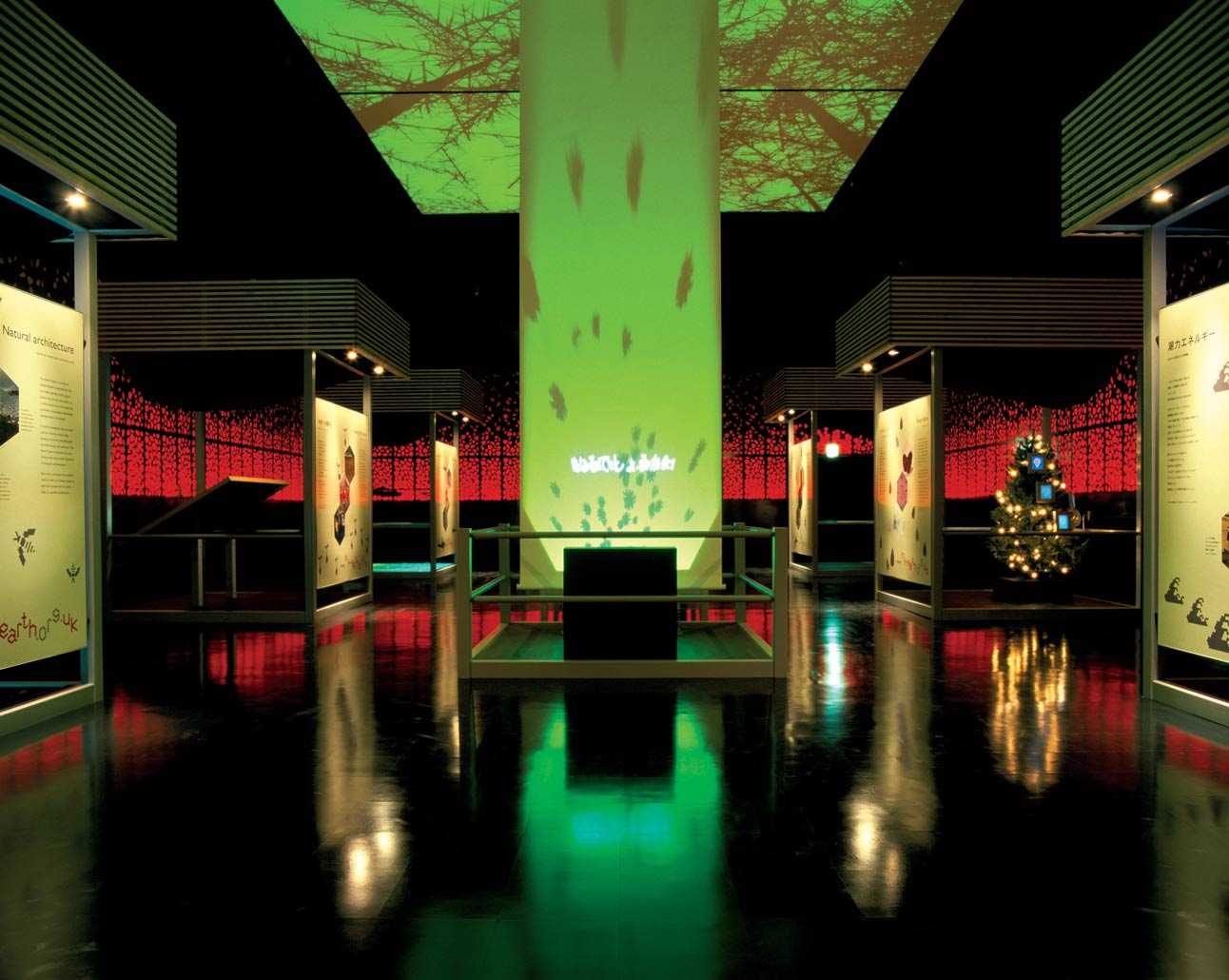
World Expos
The Playzone was considered to be the most successful installation at The Millennium Dome attracting 30k visitors/ day. With an understanding of how to entertain and articulate large visitor numbers Land have built up a reputation in creating Expo pavilions having completed two and acting as visitor experience consultants in Shanghai and Dubai.
Click on any of the projects below to see more.
Dubai Expo 2020
Location: Dubai
Completion: March 2, 2020
Dubai Expo 2021 provided the opportunity for Land to provide concept design for the Mobility Pavilion one of the three signature pavilions designed by Foster + Partners and the prestigious UAE national pavilion deigned by Santiago Calatrava. In both cases we were charged with investigating alternative movement systems and associated narrative journeys in response to these spectacular idiosyncratic architectural structures.
UAE PAVILION MILAN expo 2015
Client: National Media Council, Abu Dhabi
Budget: €8m
Location: Milan, Italy
Completion: May 5, 2015
Land were appointed to undertake the complete experience design for this £40m project working with architects Foster + Partners. It was clear that the objective was for the visitor experience design to help inform the integrated architectural process resulting in an iconic architectural pavilion. With considerable involvement in previous Expo’s, the NMC set a daily target of 8,000 visitors informing extensive visitor movement studies developed in parallel with our overall visitor experience concept
The Expo theme ‘Feeding the Planet, Energy for Life’ presented a challenge for the UAE as an oil rich country with limited food production. In spite of this, the client research team provided intriguing examples that we were able to use as a part of the communication strategy directed at a predominantly European audience. Collectively we invented a young girl ‘Sara’ who with her family became the protagonists that activated the creative narrative which we transformed into three parts. Our approach provided a controlled group of visitors with an unfolding 45-minute experience using a consistent threaded story presented within three distinctly different experiential environments.
The visitor flow had a direct impact on the architectural/ engineering brief. The optimum pulsed number of 150 visitors was predicated on a seated auditorium which formed part two of the sequence, with a movie of 10 minutes. A post show of 8 minutes and an informal queuing ramp which could easily hold two pulses of 300 people enabled us to control a throughput of 800/ hour.
The queuing ramp (Act 1) provided shade and clusters of bespoke AR media cubes augmenting kinetic models with video effects and dynamic text that entertained visitors and at the same time introduced topics recurring within Acts 2 & 3 of the experience.
At the top of the ramp, the pulse entered a golden drum into an immersive auditorium. Here a 180 degree high definition film, ‘The Family Tree’ is the emotional heart of the visitor experience. Visitors follow Sara and her family establishing how Emiratis lived frugally yet imaginatively in the past empowering us to adapt our lives as we collectively search for a sustainable future.
At a significant moment the projection screens part to reveal the third space; an immersive digital theatre which extends the preceding stories into a 25m wide transforming layered musion mechanism containing real objects. The life sized ‘virtual’ Sara is observed synthesising data and material responding to the storyline enabling us to create a powerful and compelling finale incorporating visitor participation gathered from earlier video capture.
From visitor data, The UAE pavilion was considered to be in the top three Expo attractions alongside the Japanese and German pavilions.
Shanghai Expo 2010
Location: Shanghai
Completion: March 17, 2010
For the City Being Pavilion in Shanghai, Land worked for one year with the curatorial project team at the Chinese Academy of Art to help resolve a complex narrative and the associated visitor experience. The process considered the anatomy of the city, Shanghai, as a living mechanism with a heart, digestive and nervous system and even a soul offering comparisons with other Global cities in real time.
UK pavilion aichi expo 2005
Client: Foreign & Commonwealth Office
Budget: £3.3m
Location: Aichi, Japan
Completion: March 15, 2005
Only 18 months before opening, Land were appointed to design the complete visitor experience set within a generic modular pavilion with a modest budget of £4m supported by five commercial sponsors. Shell International Ltd, GKN plc, BNFL, HSBC, Toyota (GB) plc contributed 50% of the total cost of participation.
A dense and evolving British planted garden complete with bespoke artworks created by eminent British artists provided the queuing experience. As a complete contrast, visitors entered a darkened immersive theatrical space, where Land responded to research and interpretation from our chosen partner, the Natural History Museum London enabling the design of interactive installations responding to the Expo theme of ‘Natures Wisdom’ showcasing the best of British innovation. Our task was to select from the primary research the best examples that could be transformed into compelling and diverse digital interactives. The themes and products included; tidal energy, Kew seedbank, Speedo swimwear that emulates sharkskin, and a ventilated fabric that mimics pinecones.
The proposal of a free flow layout and carefully devised interactive protocol/ dwell time/design of the installations responded to a client target of 15k visitor/day. As a result of its popularity, the pavilion was able to accommodate over 30k/day attracting just over 3 million visitors in total and was rated amongst the top 5 pavilions by its visitors.
In collaboration with the FCO and the UKTI in London we worked closely with The British Embassy in Tokyo who collectively held focus groups in Japan defining our Japanese visitor expectations as well as monitoring the use of language (Japanese & English) and an extensive communication media strategy. This involved a pre & post visit website (1m visits), the controlled use of graphics associated with the pavilion installations, branding activity and a significant nationwide TV and print media campaign which resulted in an advertising equivalency of £2.8m. Each visitor was able to takeaway a leaf souvenir
Stakeholder consensus was that the project had provided excellent value for money and had ‘punched above its weight’ compared with other participating countries with significantly larger budgets at their disposal.
2006 – Art Directors Club (NYC) Interactive, Gold Medal 2006 – D&AD Awards Digital Media, Yellow Pencil 2006 – One Awards (NYC) Digital Media, Gold Award 2006 – Design Week Awards Temporary Exhibition, Winner 2005 – Expo Association ‘Nature’s Wisdom’, Bronze Medal
Playzone at millennium Dome
Client: New Millennium Experience Company
Budget: £12m
Location: London UK
Completion: January 1, 2000
At the dome, our background in designing for ‘narrative’ gave us the opportunity to create a responsive architectural structure. We created a site specific structure with an area of 1454sqm that sat over 900sqm of retail space. The intriguing form responded to the view of the passer-by on the primary elevations. The distinctive ‘snouts’ evolved from the direct requirement for content back projection facilities; this cantilevered ‘flying lease’ effectively extended our footprint by 480sqm.
With potentially 3,500 visitors per hour, sequencing was a crucial issue. The entrance provided a controlled queuing area with preview entertainment. once inside, via an escalator, there was an option to overview the PlayZone from the ramp ‘fast track’ out, or, extend the visit to approximately 30 minutes by participating/spectating at close hand.
The organising principle of the content development, was the desire to create a highly interactive experience. our selection of new media installations presented a showcase for future play. Here digital technology was curated through a worldwide search of practitioners with some being directly developed by Land.
We believe that the opportunity to commission content, scenographic environment and architectural envelope collectively, produced a truly integrated solution, which we delivered as a complete design & build package.
‘...the PlayZone was thronged with people thrilled by digital interpretations of classic games...’ New Yorker
A History of the Future: A rare insight into experience design
2000 – FX Design Awards Entertainment Venue, Winner 2000 – ID Magazine (NYC) Interactive Media Design, Silver Award for ‘Kids Room’
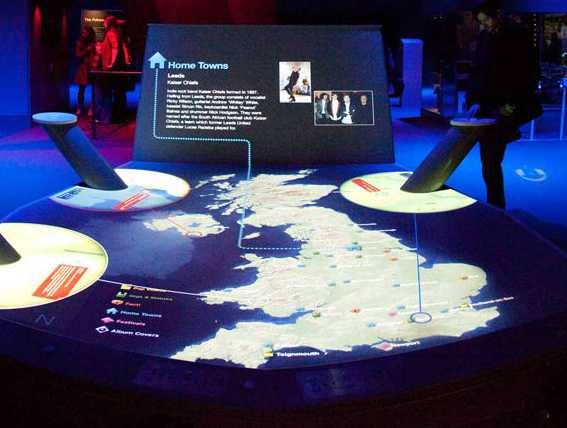
Brand & Popular Culture
These projects enabled us to exploit our skills in the use of interactive digital media.
Click on any of the projects below to see more.
The British Music experience
Client: Anschutz Entertainment
Budget: £8.0m
Location: O2, London UK
Completion: March 15, 2009
Following a creative pitch, Land Design Studio were appointed by Anschutz Entertainment Group Europe in early 2006 to design a permanent exhibition dedicated to the history of popular music in Britain. The exhibition is located on an upper level adjacent to the arena and not only features music created in the British isles but also reflects international artists who have found their inspiration or audience within the UK.
The design process of this fast track project was iterative, tracking the evolution of the brief by working with music industry experts. in parallel, the curatorial team had to undertake object collections and asset acquisition from scratch.
The starting point was the architectural modelling of a complex irregular space into a logical sequence that involves a pulsed 5-minute entry and exit helping to set up and conclude the experience. An important design feature is the ability to convert the exit sequence of the exhibition into a 300 cover events space for corporate evening use.
The main exhibition combines chronological zones with thematic installations. The nature of popular music has encouraged the unprecedented use of digital media, with a mixture of interactive and linear applications, that combine with a coveted collection of music memorabilia. There is an interactive studio where it is possible to play instruments.
Extensive RFid technology responds to visitors as they move through the whole exhibition space enabling them to tag content and areas of interest that may be re-visited on the dedicated website after the visit.
‘It’s a sort of comprehensive, conceptually flamboyant Wikipedia history of British pop music in shape-shifting multi-dimensional interactive form.’ Paul Morley, The Observer Music Monthly
2011 – European Museum of the Year, Special Commendation
the famous grouse experience
Client: Highland Distillers Ltd
Budget: £2.0m
Location: Crieff, Perthshire, UK
Completion: June 13, 2002
The complete re-development of this Visitor Centre was undertaken by Land in 2000. The strength of the original guide-led manufacturing process was maintained whilst the construction of a new pavilion enabled us to provide a nosing demonstration and a pre-show introducing a spectacular finale.
A refurbished 18th Century cottage provided the ideal opportunity to create a memorable interactive experience set within a sophisticated sensory environment. The concept is drawn from the leitmotif of the award winning TV commercial.
Seismic floor sensors combined with a series of six computer processed data projectors enable groups to splash through digital water, crack digital ice and fly across ever evolving Scottish landscapes. Once the eight minute show is complete, the management of the movement sequence delivers the pulsed group directly into the refurbished shop and restaurant.
‘... Lands solution effortlessly mixes technology and heritage...’ FX Magazine
2003 – Art Directors Club (NYC), Silver Medal 2003 – Marketing Brand Design Awards Brand Experience, Winner 2003 – Marketing Brand Design Awards, Best in Show 2002 – BAFTA Interactive Award Sport & Leisure, Winner 2002 – FX Awards Entertainment Venue, Health &Fitness, Winner
URBIS
Client: Manchester City Council
Location: Manchester
Completion: June 4, 2002
Land have developed 2 of the 4 galleries set within Urbis, a structure designed by architect Ian Simpson that investigates the concept of the modern city. The objective was to help demystify and assist in understanding wide ranging personal relationships with the city by using Manchester as a portal to other cultures and situations on a global scale.
CHANGE [Gallery] uses a range of interactive situations to consider how people influence and are influenced by the city they call home. Life sized people pods and a bespoke ‘blue screen’ sequence engage the visitor with real people and their actual city.
EXPLORE [Gallery] is encountered through an award winning module that provides a unique interface enabling access to an extensive database exploring how people have imagined the city. Beyond this, ‘Urbisville’ presents a self styled matrix that investigates the diversity and compelling narratives of six cities and five themes. This finale intentionally encourages a free flow movement system.
2003 – Design Week Awards Permanent Exhibition, Winner 2003 – Art Directors Club (NYC), Silver Medal 2003 – ID Magazine (NYC) Interactive Media Design, Gold Award
MOVING PICTURES
Client: BFI: Museum of The Moving Image
Budget: £500,000
Location: UK
Completion: January 25, 2002
The brief to design a touring exhibition for the British Film Institute (BFI) resulted in a series of environments that describe how cinema and television have become such an engaging and inspirational part of our lives. The design caters for a broad audience appeal, with a strong focus on families and school groups. a programme of educational activities for both formal and informal learners will accompany the exhibition.
live interpretations, film projection and classic video footage combine with the exhibits to bring TV and cinema to life, and guide visitors through the rise of each from the 1930’s to the present day. Finding little in the way of temporary systems that were sturdy enough to cope with the demands of venues, land devised a bespoke system using steel frame and mesh.
The structure allows for simple and effective application of moving image, lighting, graphics and displays. Land believe that this initiative has provided the opportunity to demonstrate that new standards in quality interpretation display and design can be achieved with a modest budget to support the ever growing demand for touring exhibitions.
"... a series of environments that describe how cinema and television have become such an engaging and inspirational part of our lives..."
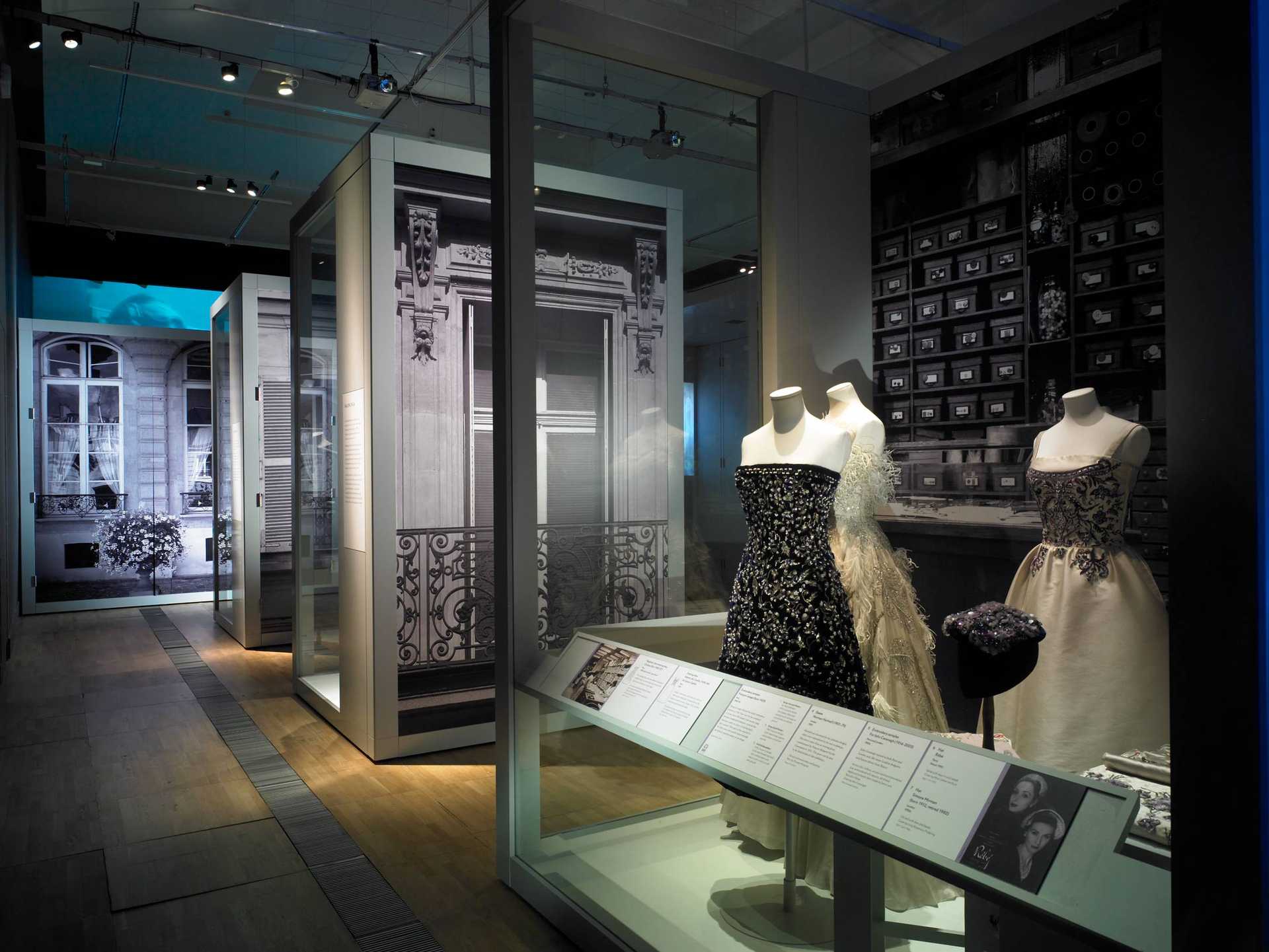
Art & Design
As designers we have always enjoyed deconstructing the creative design process and helping audiences appreciate the craft and the skills involved.
Click on any of the projects below to see more.
ROYAL STYLE IN THE MAKING
Client: Historic Royal Palaces
Location: Kensington Palace London
Completion: December 2, 2022
Land Design Studio were appointed by Historic Royal Palaces to stage an exhibition dedicated to Royal Style located in the famous baroque Orangery built in 1704 by Nicholas Hawksmoor at Kensington Palace. This was a unique opportunity to use this space for an exhibition as it is usually used as a restaurant, but the client took advantage of major renovation work being undertaken on the site which enabled limited access to the spectacular space.
The programming of access to the Orangery meant that inevitably it would be open at the time of significant Covid restrictions, so we were required to acknowledge this through the design proposals. Timed ticketing meant that we were able to predict dwell times for viewing vitrines and communication media and in consequence create an appropriate comfortable sequencing of visitors through the spaces. In addition, we had to incorporate natural ventilation to ensure suitable air exchange.
The Orangery provided a perfect classical backdrop within which we were asked to demonstrate the work of 5 Royal designers from the 1930’s to the 1990’s; Madame Handley Seymour, David & Elizabeth Emanuel, David Sassoon for Bellville Sassoon, Norman Hartnell, and Oliver Messel. Using elegant vitrines for the clothes and atelier materials alongside rare archive footage we were able to capture the central qualities talents and skills of the designers. Our client guided us to show the process of lengthy consultations, modifications and fittings that had to be undertaken for approval, also it was necessary to highlight the skills of the atelier workshop teams that cut sewed and embellished the clothing to make the designers ideas a reality.
The inevitable highlight of the exhibition presented Princess Diana’s wedding dress complete with full train in an 8 metre long case.
A SENSE OF WONDER
Client: Pitzhanger Manor & Gallery
Location: Ealing London, UK
Completion: January 7, 2022
This is an exhibition dedicated to a world inhabited by a group of rusty robots as they experience the very best of human emotions within both utopian & dystopian landscapes. The artist Matt Dixon is an illustrator and concept artist with more than 30 years’ experience in the video games industry. The curator/auteur Rob Dickins conceived the concept which involved the transformation of computer-generated images into large scale high-end photographic prints and some captivating 3D modelling.
Within the daylit gallery, our design intervention uses closed cubes to provide light controlled theatrical settings for the model vignettes, along with ‘selfie’ opportunities and also help articulate movement through the gallery. An immersive soundscape and artificial grass floor provide an appropriate surreal atmosphere that segway’s into a darkened media space presenting powerful backlit images. Our extended contribution involved the production of a movie describing the artist’s origin and processes as well as the use of AR technology enabling mobile phones to augment selected lightboxes by using Instagram, in consequence the visitor can actually take the ‘Empathy’ robot home with them.
Baroque
Client: Victoria and Albert Museum
Budget: £0.65m
Location: London UK
Completion: April 17, 2009
The V&A brief encouraged a response from Land to develop a series of evolving environments. The extraordinary collections and the curatorial imperatives elicited distinctive scenographies using architecture, graphic information, colour, lighting, sound and moving image.
The introductory gallery ‘The First Global Style’ presented the starting point with a conventional gallery layout that helped provide the visitor with an overview demonstrating how baroque developed to be the first movement in art that proved to be truly international.
With the transition into the north gallery, ‘The Theatre’ marked the first change of atmosphere. The ‘theatrical’ setting provided the artifice that continued to be used throughout the rest of the exhibition, and, in reference to the central concept of baroque, ‘the world as a stage’, blurs the boundaries of real and imagined spaces. For ‘The Square’ a scenically painted urban space unfolded as background to ‘processional’ objects and associated media. As the visitor moved into ‘Sacred Spaces’, the installation of the backlit dove created a strong axial attraction, thus affirming the notion of religion as one of the starting points of baroque style.
Much of this ‘non secular’ theme benefited from a bigger volumetric space which Land exploited using judicious theatrical scenic painting enhanced with music contextualising the objects and the space. A painted pozzo framed the magnificent Mexican altar. The sense of procession and axial movement continued as an intentional device to achieve the strong sense of perspective and point of view prevalent in baroque art and architecture. In the final gallery ‘Secular Spaces’ a shifted axis provided the transition through contextual spaces (rather than galleries) that symbolically represented the succession from the public space to the more intimate areas of the baroque palace.
The Golden Age of Couture
Client: Victoria and Albert Museum
Budget: £0.53m
Location: London, UK
Completion: September 19, 2007
For this exhibition that draws most of its objects from the Victoria and Albert Museum’s own collection, Land’s design scenography treated the presentation of “one of the most glamorous decades in fashion history” as if it were a totally immersive theatrical production, with five scene changes.
Starting with the impact of Dior’s “new Look” in 1947, the manufacturing process was explored in a filmic street scape of vitrines that transform from atmospheric exteriors to fascinating interior contextual displays. This was followed by a fashion photography gallery and an open catwalk display of tailored suits and day-wear.
The penultimate gallery featured a large show case installation complete with a mesmerising Osterley House video and Mantovani soundtrack that provided the grand setting for 35 ballgowns including those worn by the Queen, Margot Fonteyn and Audrey Hepburn.
In total contrast the finale presented the contemporary legacy through the work of John Galliano and an intriguing, large-scale timeline, tracking designers and couture houses from both Paris and London.
‘...as rich and graceful as the women who originally purchased and wore the clothes.’ Newsweek
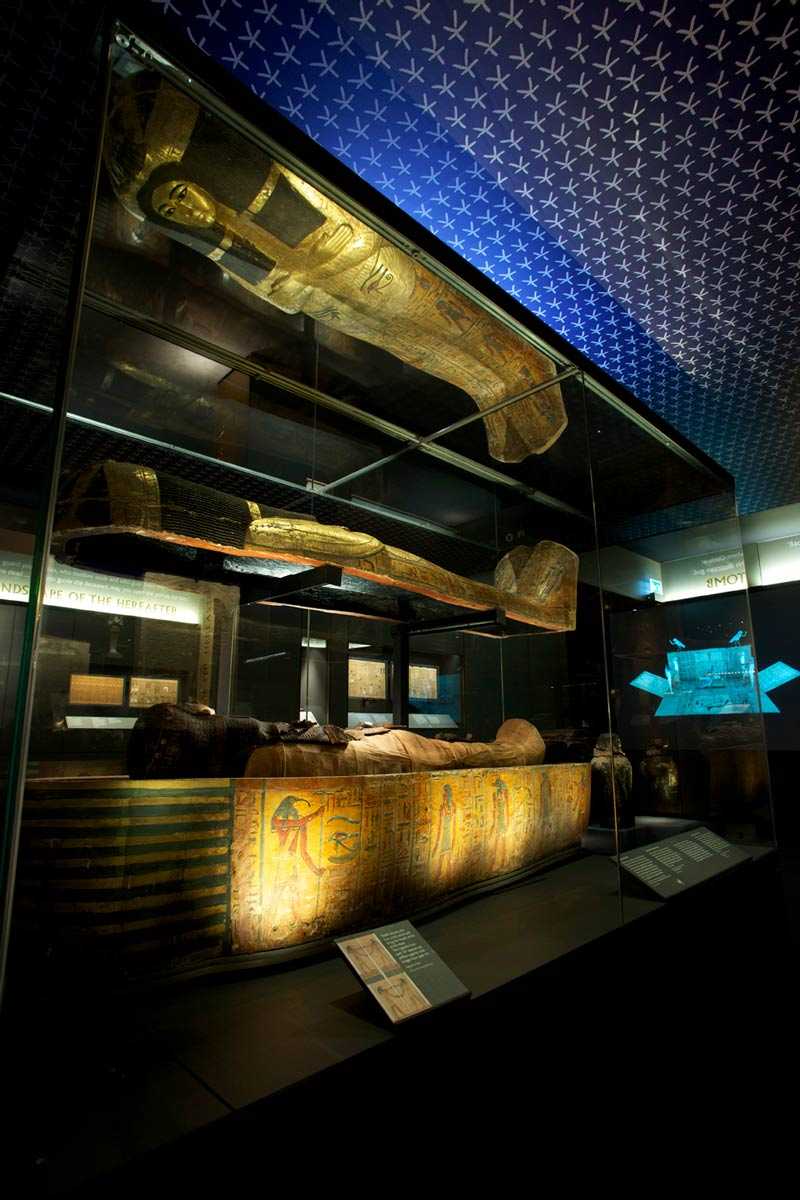
History & Archeology
Two high profile temporary exhibitions were completed for the British Museum and a significant lottery funded permanent exhibition in Swansea for the National Museums of Wales.
Click on any of the projects below to see more.
ST ELMO’S FORT
Client: Heritage Malta and Grand Harbour Regeneration Corporation
Budget: £4.5m
Location: Valetta, Malta
Completion: May 17, 2015
Land completed in 2015 the £4.5m military museum at St Elmo’s Fort, Malta. Embedded within a £15m conservation project the experience sits within a world heritage site in Valetta, Malta.
The narrative focuses on the diverse military history of the fort since the first siege of Malta in 1565 through to its critical involvement with the allies in WWII. As the project was funded by the ERDF it was subject to an International design competition.
Land elected to form a joint venture team, which included local architects Forward Architects and London based content developers TGAC, lighting designers ZNA and graphic designers Surface3.
In response to the brief, Land undertook the role of ‘expert museologists’ and produced the concept and scheme design as well as the principle for all software, object displays and integration of graphics.
The limited experience of the client, Heritage Malta and local main contractor Camray extended our involvement at all stages especially with the curation of objects and the complex integration of lighting, hardware and software development.
“Amazingly unexpected. I thought this was going to be a historically interesting attraction, but nothing more... It turned out to be one of the best museums I have ever been to. The way they have presented the information is in so many different formats that it is impossible to get bored.” Tripadvisor, 2015⭐⭐⭐⭐⭐
POMPEII & HERCULANEUM
Client: The British Museum
Budget: £0.5M
Location: London UK
Completion: April 22, 2013
‘One of the most momentous archaeological exhibitions ever staged’ Jonathan Jones -The Guardian⭐⭐⭐⭐⭐
‘An unparalleled picture of life in ancient times, explored in a magnificent and moving new show’. Rachel Campbell-Johnston, The Times⭐⭐⭐⭐⭐
‘A show that reincarnates a distant time and place with stunning immediacy, while constantly serving a grim reminders of its end’ Andrew Graham Dixon- The Sunday Telegraph⭐⭐⭐⭐⭐
‘I can tell you that nothing I have seen or read before tells the story in the way The British Museum does. As we walk through the show we are unconsciously getting to know those people- and by knowing them we come to care about their fate.’ Richard Dorment- The Telegraph⭐⭐⭐⭐⭐
‘Because of the quiet, meticulous and unemphatic way it has chosen to concentrate upon the story of the everyday, and having done so, to conclude with a dramatic presentation of body casts. Its triumph then is in its pacing’. Michael Glover- The Independent
‘This brilliant and intelligent show paints a vivid picture of everyday life in the shadow of Vesuvius’ Brian Sewell- Evening Standard
egyptian book of the Dead
Client: The British Museum
Budget: £0.5m
Location: London UK
Completion: October 9, 2010
Staged in the Reading Room in the centre of the Great court, this exhibition sets out to explain the context of The Book of the Dead which was a ‘manual’ that would help steer the deceased on a long and perilous journey to reach the safe haven of eternal paradise.
The organising principle was drawn from a very simple diagram that described the journey of the sun god Re, who travelled on a circular trajectory through day and symbolic night, emerging triumphant with the morning sun. This construct encouraged us to dissect the circular space into two parts; a primary labyrinthine experience that provided the interpretive episodic context of the journey and a significant curved open space symbolically representing the afterlife as a finale.
A series of monolithic structures built out of slabs and beams provided the mechanism to display the extensive papyri, coffins, mummy cases, funeral masks, amulets stalae, stone carvings and figurines. Two distinctive chambers, a Tomb and the Hall of Judgement provided appropriate breaks in the rhythm of the intentionally disorientating journey. Subtle but large scale projected media is used to augment the small scale and low-lit detail embedded in the papyri.
The use of dynamic lighting onto the curved cyclorama and a commissioned soundtrack provide the theatrical setting for the final display; the 40m long ‘Greenfield Book of the dead’.
“Welcome to paradise in a show to die for.” Rachel Campbell-Johnston, The Times⭐⭐⭐⭐⭐
“You will never see this peerless collection in this way again.” Charles Darwent, The Independent
National Waterfront Museum Swansea
Client: National Museum Wales
Budget: £7.0m
Location: Swansea, Wales
Completion: October 27, 2005
Land’s unprecedented early appointment alongside Wilkinson Eyre enabled us to develop the masterplanning in parallel with the narrative / interpretive process.
The incorporation of the city plan and need to establish a cultural quarter impacted on components of the combined new building and restored Victorian railway shed. In detail the solution acknowledges the changes in the way that people use museums as a result of free access, and responds to the day to day experiences of people and communities in Wales through contextual objects and material to access wider themes of technological and social change over historic time and also into the future.
NWMS provides opportunities to create a museum based on entertainment value as well as the inspirational and educational, and in consequence encourages visitors that may otherwise not consider themselves attracted to such established institutions.
‘...The National Waterfront Museum will be the jewel in the crown of Swansea’s waterfront regeneration and a powerful magnet to draw in visitors to learn about our fascinating maritime history and industrial history, as the world’s first industrial country.’ First Minister, Rhodri Morgan AM
2006 – Association for Heritage Interpretation, Special Award
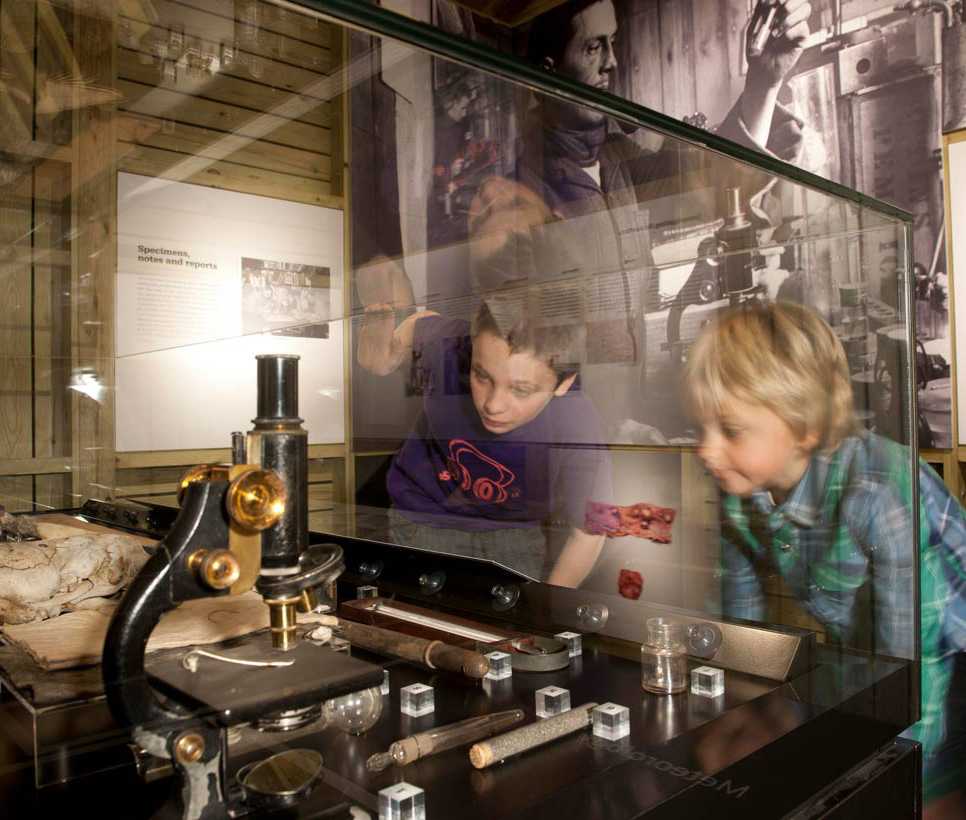
Natural History Ecology
Land have completed both permanent & temporary exhibitions in this field for major National museums including many for the Natural History Museum in London. International projects include the highly successful Gardens By The Bay Singapore.
Click on any of the projects below to see more.
GARDENS BY THE BAY / MARINA SOUTH
Client: National Parks Singapore
Budget: $14.0m SGD / £7.0m GBP
Location: Marina South, Singapore
Completion: August 11, 2012
Gardens by the Bay is set within a 54 hectare landscape composition that has a united beauty and magnificence that resonates with the idea of Singapore as a City in a Garden. Land have created the interpretation and educational programme working as part of a consortium led by Grant Associates (Landscape Architects) alongside Wilkinson Eyre (Architects) Atelier One (Structural Engineers) and Atelier Ten (M&E Engineers).
As experiential designers we were invited by the client to track the 6 year development programme undertaken by the hugely creative team. Many of the principals were known to us through previous collaborations but the revelation was that our client NParks were prepared to embrace our potential contribution from the very beginning. In consequence we were able to witness the evolution of the narrative landscape masterplan, the spectacular cooled conservatories and audacious supertrees which have been integrated into an holistic engineered garden ecosystem. Our task has been to exploit many forms of communication media to help unlock the compelling stories that have been generously enabled within these visual and sensory spectacles. Hopefully some of our visitors will become knowledgeable ambassadors, celebrating horticultures and biodiversity and raising awareness of important global issues such as water and energy management as they travel on their way.
Project leader Andrew Grant reminded us “Over the period of the project we have absorbed much of the intricate Asian thinking to create a richly detailed composite of garden culture and design. Much of this can be attributed to the special bond that has developed between East and West, client and design team.“
‘The scheme is an outstanding example of sustainability in action, not only representing best practise but also communicating important messages about these issues to a wider public’ - Judges’ citation Lubetkin Prize
Scott’s Last expedition
Client: Natural History Museum
Budget: Undisclosed
Location: Sydney Australia , London UK
Completion: September 30, 2011
This exhibition was a collaborative project between the Natural History Museum London, New Zealand Antarctic Heritage Trust, and Canterbury Museum, New Zealand.
The stakeholders collectively appointed Land to design an exhibition which would tour Sydney (Australia), Christchurch (New Zealand) and be the major Natural History Museum London exhibition during 2012.
The exhibition focuses on Robert Falcon Scott and his teams’ final expedition to Antarctica. A journey with a well documented ending, but with many unknown facts about science and endeavour.
Using a representation of Scott’s cape Evans Hut as the organising principle, the exhibition explores the varied activities that took place within the hut and how the expeditions were planned and prepared. The stakeholders have brought together a unique collection of artefacts from the 1911 polar journey, alongside original photography from Herbert Ponting (Scott’s expedition photographer), which provide a unique insight into life in Antarctica.
We have taken the opportunity of using the Ward room table as a media installation. Projected images represent the compelling range of activities that took place here such as dining, expedition planning, and the gathering of collected objects to be used for scientific research.
The exhibition also gives an insight into the lure of Antarctica, life in Edwardian Britain and the numerous unknown scientific discoveries made by Scott’s team and brought back to the Natural History Museum. The finale provides an insight into the contemporary perception of captain Scott and the legacy of his polar expeditions.
Museums + Heritage Awards 2013 Winner – Best Temporary & Touring Exhibition
ICE STATION ANTARCTICA
Client: Natural History Museum
Budget: £0.73 m
Location: London, UK
Completion: May 23, 2007
The brief from the Natural History Museum was to design a robust Antarctica themed touring exhibition that, as part of its partnership with British antarctic Survey, would be the highlight of International Polar Year and would attract up to 1200 family visitors a day.
Land’s concept was to develop ice Station Antarctica, a collection of engaging interactive challenges that assess whether or not younger visitors could survive the extreme conditions faced by scientists researching the coldest, windiest and most remote place on earth... Antarctica.
The activities were set within glowing inflatable pods that were distributed throughout the exhibition space. in response to the Natural History Museum’s ‘virtuous circle’ initiative to extend the visitor experience beyond the museum, visitors followed a digital trail that revealed how suited they are to working in Antarctica, as well as allowing them to build on their new Antarctica skills online at home.
The ice Station commander encouraged participants to undertake such activities as: driving a virtual skidoo; exploring the ocean with a team of deep-sea divers or experiencing sub zero temperatures within a bespoke freezer room.
Land was encouraged by the Natural History Museum to develop an integrated graphic design communication strategy. Using the exhibition graphics as a starting point, the design approach was effectively adapted for merchandise, website and even marketing initiatives.
Dinobirds
Client: Natural History Museum
Budget: £0.4m
Location: Europe
Completion: July 25, 2002
Land Design Studio was appointed by the Natural History Museum following the discovery of a spectacular series of fossils in a limestone quarry in china. These rare discoveries convincingly demonstrate the evolution of the dinosaur into the bird. This controversial thesis has been debated within the scientific fraternity for some time and provoked the need for an exhibition to rationalise and describe the investigative process.
Since the inception of free-access, there is the overwhelming need for National Museums to create high-quality, touring exhibitions. in response land produced a low-cost, modular system that defies this utilitarian need by creating a variety of immersive environments with communication media worthy of a permanent installation. The inevitable constraints of touring exhibitions need significant re-evaluation, and land was delighted to have the opportunity to work with the NHM on this prestigious event.
"...a low-cost, modular system... creating a variety of immersive environments..."
Millennium Seedbank
Client: Royal Botanic Gardens Kew
Budget: £700,000
Location: Wakehurst Place UK
Completion: February 16, 2000
The millennium Seedbank Project is an International collaboration funded by the Royal Botanic Gardens Kew, which aims to safeguard over 24’000 plant species world wide against extinction and to secure the future of the UK’s native flowering plants.
Within the 5,500Sq.m building the exhibition interprets the research and conservation facilities and in addition, describes the function of the vast underground vaults that store the seeds at -20°c. In response to the secreted, uninspiring objects, land have devised an interpretive installation that relates significantly to the architectural language of the structure.
Elegant graphics and displays are sensitively located in the space, whilst simple interactive media connects the visitor to the scientists working in the adjacent laboratories.
"With impeccable understatement, the exhibition design is entirely in sympathy with Stanton Williams’ architecture...’ Building Design"
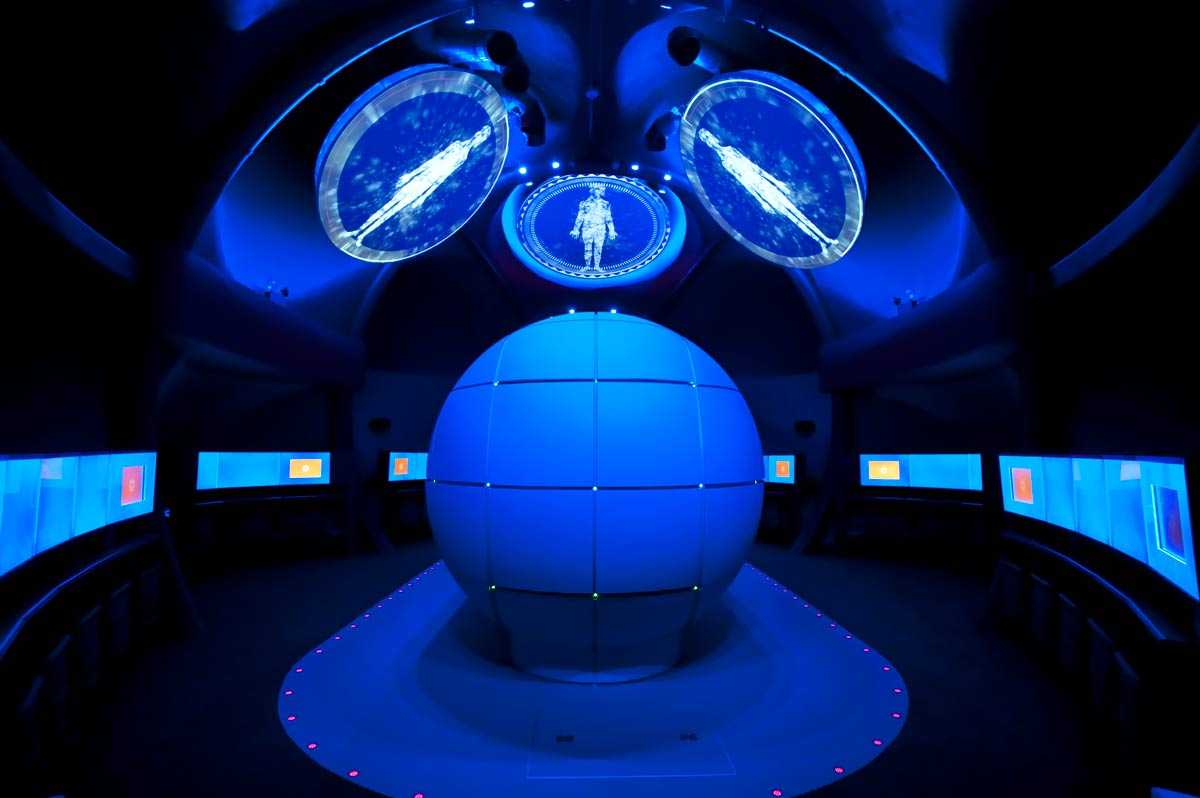
Science Education
These educational initiatives always involve extensive primary research dedicated to informal learning programmes that complement the more formal school curriculums.
Click on any of the projects below to see more.
Sutton Life Centre
Client: London Borough of Sutton
Budget: £8.15m
Location: Sutton UK
Completion: June 20, 2010
In 2008 Curl La Tourelle architects invited Land Design Studio to help create a new hybrid building typology that combines a district library, external sports facilities, eco garden and an immersive experiential ‘Life centre’. The unusual collaboration between the architect and the design team was encouraged by the client; Sutton Borough council.
The Sutton Life centre was an important part of the client brief to provide informal learning facilities for primary and secondary schools. Three classes of Year 6 or Year 8 may be pulsed through a 90-minute sequence. This experience combines aspects of scenographic filmic and theatrical conventions alongside digitally generated environments incorporating high quality projection, dynamic sound and lighting, and a bespoke use of radio, TV and computers in a domestic setting. it is part; movie set, media lab, educational facility and community centre. All digital media was developed by Studio Simple in close collaboration with Land and lighting design company DALD.
The unprecedented combination of this media set within an architectural context is programmed to create an extensive variety of memorable narrative scenarios that communicate critical everyday issues that are faced by children in the UK. Subjects investigated include; drug culture, the dangers of alcohol, cyber bullying, life threatening hazards in both domestic and urban environments and even the need for intelligent waste disposal by creating a life sized immersive land- fill site. The programme supports the educational PSHE curriculum.
Both the library and the ‘Life centre’ maintain a physical architectural relationship and take advantage of important functional links that could, if exploited, help extend its potential daily / weekly lifecycle, and help reinvent the concept of community centre.
“We see tremendous value in this resource and applaud Sutton Borough council for its imaginative approach to the issues.” Sarah Haddon, Suzy Lamplugh Trust
2010 – Suzy Lamplugh Awards Safer Community Award, Winner
Centre of the ceLL
Client: Centre of the Cell
Budget: £2.5m
Location: Whitechapel, London UK
Completion: December 5, 2009
Originally delivered in 2009, the Centre of the Cell is a unique and creative response to the need to improve young people’s knowledge about their cells and bodies in sickness and health. aimed at school children and their teachers, the Centre of the Cell is an interactive exhibition in East London and an on-line education resource.
Land Design Studio were appointed in early 2005 to design the Centre of the Cell. When it opened on the 3rd September 2009, it was the first science education centre in the world sited within the working research labs of a major medical school; the new institute of Cell and molecular Science at Bart's and The London, Queen Mary’s School of medicine and dentistry. Making the work of research scientists visible and more relevant to the lives of the young people, the Centre of the Cell provides a memorable and theatrical experience to inspire the scientists and health professionals of the future.
The building is designed by Alsop/Amec, a landmark building in an area greatly in need of urban regeneration, close to The London Hospital.
“if it’s memorable then they’ll never forget. For some visitors it could be the trigger to take up a career in science or medicine.” Professor Frances Balkwill, Director of the Centre of the Cell and the 2005 Michael Faraday Prize winner
2010 – Museums and Heritage Award Best Educational Initiative, Winner 2010 – BT Visit London Award 2010 Best New Tourism Experience, Finalist
FUTURE MEDICINE
Client: Miraikan, Museum of Emerging Science and Technology
Budget: £0.5m
Location: Tokyo, Japan
Completion: December 7, 2006
This is Land’s second project in Japan, following their hugely successful UK Pavilion for the World Expo in Aichi. The exhibition focuses on the emerging technologies and latest scientific research that will shape medical care in the years to come.
The design of the exhibition is a radical departure from the other existing museum spaces and it is the first time that a foreign company has been invited to collaborate on such a project.
The new design wraps the visitor in an illuminated graphic wall and cocoons them in order to encourage a high level of concentration necessary for such complex content. The immersion is further supported by a containing ceiling of reflective discs and a specially commissioned 6-channel soundtrack by A Man Called Adam.
The graphic walls, with patterns inspired by DNA arrays and genetic sequencing, and consoles contain all the audio visual and interactive exhibits, leaving a clean, dramatic space with the sense of a laboratory of the future. after the first two zones, which deal with Diagnosis and cure, the final area is conceived as a space for relaxed reflection, discussion and encourages the visitor to debate and formulate opinions on the latest ethical issues, such as embryonic stem cell research.
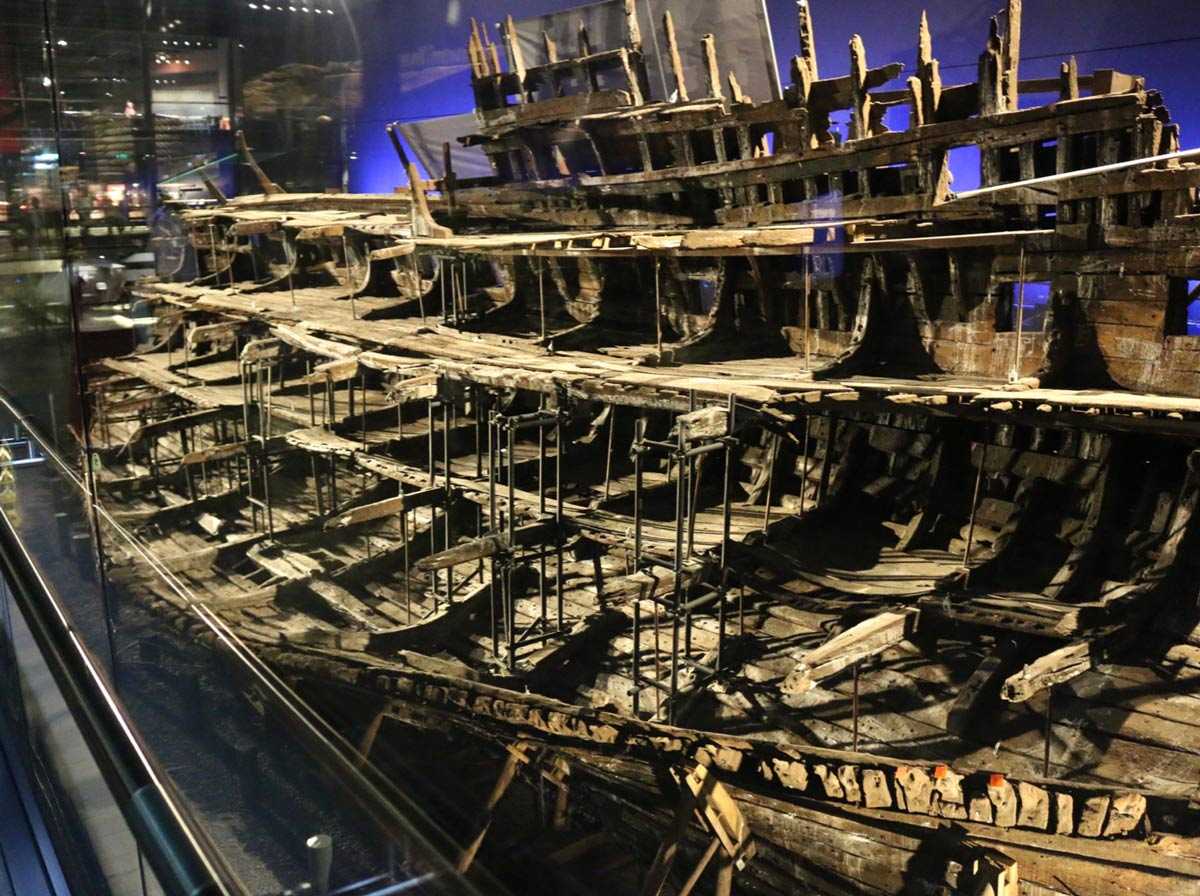
maritime history
Land have been involved with British maritime history over many years since our first ever commission at the National Maritime Museum Greenwich. We have enjoyed a long term relationship with Chatham Historic Dockyard and The Mary Rose Museum in Portsmouth.
Click on any of the projects below to see more.
COMMAND OF THE OCEANS
Client: Chatham Historic Dockyard
Budget: £900k
Location: Chatham, UK
Completion: May 7, 2016
This is a new permanent display at The Historic Dockyard Chatham – the most complete dockyard from the ‘Age of Sail’ to survive anywhere in the world. The £9m project has been made possible with support from a £4.8m grant from Heritage Lottery Fund (HLF), and various other funders.
‘Command of the Oceans’ is the starting point for telling the story of the Dockyard’s role in British naval supremacy from the 16th century through to its golden period of the ‘Age of Sail’ from 1700–1820 when the Dockyard’s shipwrights designed and built ships that transformed the British Navy into the most powerful sea force in the world. The exhibition is built around the 260-year old skeleton of the Namur, preserved where she was discovered and still lies.
Here at Chatham Land worked continuously alongside the architects, Baynes & Mitchell who have articulated physical space to accommodate the exterior public realm, listed building and conservation sensitivities, massing, flow, changes of level, adjacencies, materiality, light & sound and operational imperatives.
Seamlessly, the architectural framework (described above) responded to the refined need for a narrative journey driven by interpretation. New has had to be knitted into old, light and dark rationalised, most importantly there is a precise historic story to be told through a complex movement sequence, eventually revealing extraordinary archaeological secrets contained deep within the fabric of the structure.
It is within this organising principle that we have been able to provide the next layer of intervention using communication media. With fascinating opportunities available to us we have been encouraged to integrate a diverse range of digital and analog media including: graphics, atmospheric lighting, dynamic orientation mapping, time-based context and reportage style documentary video, immersive digital theatre, children’s hands on interactivity, object display, science based archaeological interpretation, completed with an audio scape finale.
Over 8 years Land have enjoyed supporting the Dockyard Trust by completing three projects that respond to carefully defined visitor profiles, educational and outreach programmes whilst at the same time providing important tourism benefits for the region.
HEARTS OF OAK
Client: Chatham Historic Dockyard
Budget: £650k
Location: Chatham, UK
Completion: May 9, 2013
This project resulted from a carefully constructed collaboration between exhibition designers Land Design Studio and digital media designers ISO Design on behalf of Chatham Historic Dockyard Trust.
The client brief was to re-purpose existing theatrical settings representing 18th century Chatham Dockyard, which were originally built to a very high standard in 1985. The creative solution replaced the original static figures with a fluid time-based media event using digital projection in conjunction with a sensitively designed soundscape.
The new installation may be described as ‘digital promenade theatre’ where visitors engage in a 30 minute sequence that enables them to follow a retired shipwright John North on a journey through the dockyard with his grandson.
The projected full-size characters are joined by others along with augmented graphics and images as they pass through fully immersive scenes such as the timber pile, the mould loft and gun deck. The combination of high end media embedded in the theatrical setting creates a new interpretation technique that brings the story of people, ships and processes to life in a vivid, engaging and memorable way.
“...the Dockyard needs a full day to see everything and this is one of their latest attractions, and is advertised as ‘digital theatre’ and an exciting new visitor experience, and it certainly lives up to this claim... Very atmospheric and technically very high quality. A great addition to the attractions here.” Tripadvisor, 2013 ⭐⭐⭐⭐⭐
MARY ROSE MUSEUM
Client: Mary Rose Trust
Budget: £3.4m
Location: Portsmouth UK
Completion: May 5, 2013
The universal acclaim for The Mary Rose has compared this unprecedented celebration of Tudor History with the discovery of Pompeii. It may be serendipity that ‘Pompeii & Herculaneum’ presented by the British Museum in March 2013 was also designed by Land Design Studio.
The vision of The Mary Rose Trust to bring together the complete creative team from inception has encouraged the highly collaborative process involving Land as interpretive exhibition designers in the progressive iteration of architecture, interior design, engineering as well as the extraordinary conservation archeology and curation provided by The Mary Rose team.
Presented as a unique snapshot in time moments before the ship sank before King Henry VIII in 1545, we believe that The Mary Rose Museum is a fine product of the integrated solution and in consequence an exemplar for museum making in the 21st Century.
“The Mary Rose is one of the most important objects in English History. It’s up there with the Doomsday Book, the Magna Carta, and Hampton Court. Indeed I would go further. The Mary Rose is the English Pompeii or Herculaneum; all Tudor life is there.” David Starkey, 2007
2015 – European Museum of the Year Award, Special Commendation and Finalist 2014 – Museums and Heritage Award Best Permanent Exhibition, Winner 2014 – Art Fund Prize Museum of the Year, Finalist
No1 Smithery
Client: The Historic Dockyard Chatham
Budget: £1.0m
Location: Chatham, UK
Completion: March 13, 2010
Land were part of the design team led by van Heyningen Haward architects to transform the dockyard’s former Smithery, a Scheduled ancient monument and Grade ii* listed building, in order to house and display the largest collection of maritime models in existence.
The project was a partnership between the national maritime museum, imperial War museum and Historic Dockyard Chatham to bring together their extensive and varied collections of maritime models. The primary concept is to provide a ‘building within a building’ in order to meet the highest environmental and security standards maintaining the original historic context with minimal impact on the structure.
The building contains 3 main gallery areas for both permanent and temporary exhibitions along with an interpreted pipe bending floor where visitors and school groups alike can understand the activities that took place in it’s former life. a series of repositories sit within the Smithery for the storage of the collections with controlled public viewing. The display requirements for the models encouraged an extensive search for the appropriate case construction which form the centrepiece of a media rich design strategy.
“The explanations of the artefacts are brilliantly done throughout the new display, juxtaposing artworks and interactive tools that really bring this collection alive.” Kieran Long, Evening Standard
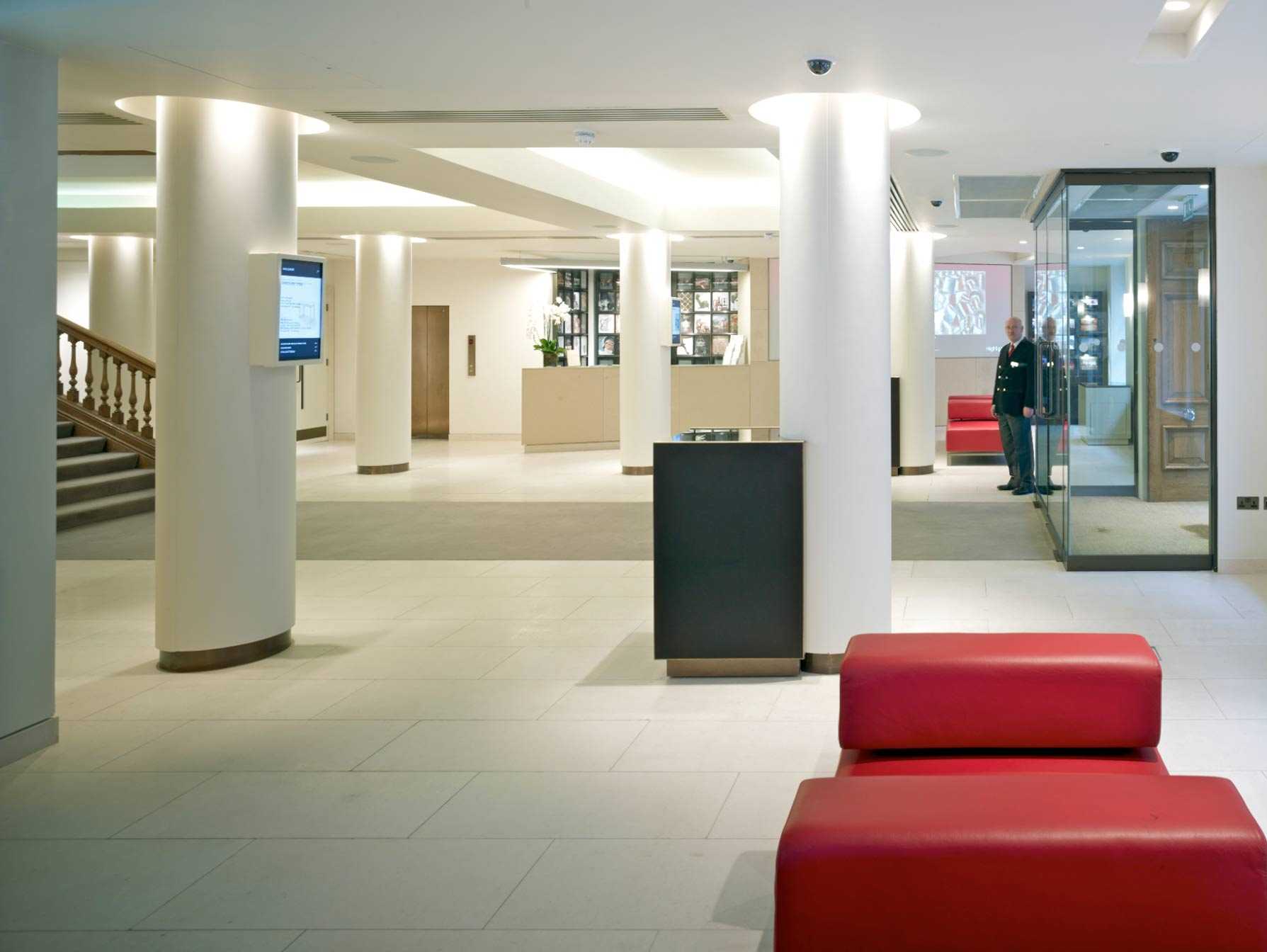
Interior Design
With an original background in Interior Design Land re-designed Christie’s HQ in Mayfair and the Eurostar First Class lounge at St Pancras.
Click on any of the projects below to see more.
Christie’s
Client: Christie’s
Budget: Undisclosed
Location: King Street, London UK
Completion: November 5, 2011
The refurbishment of Christie’s UK Headquarters in St. James’s, Piccadilly was delivered across four phases. a collection of historic and listed buildings from King Street to the South & Ryder Street to the north have been transformed over a series of intense summer months across 4 years to provide an integrated and seamless customer flow and orientation with a design that reflects the Christie’s brand and values.
Phase 1 – King Street Front of House. Re-planning the sequence of movements through the ground floor reception, cashiers and collection area and consulting rooms that help present a clarity a re-definition of activities. a new platinum gallery, know as the duke Street Gallery, was created with the opportunity to enhance the quality of finishes and fixtures. A distinctive feature is the introduction of projection, interactive media and tuneable lighting.
Phase 2 – King Street Sales Rooms. Refurbishment of the first floor display and sales galleries to incorporate new architectural feature rooflights, services, furniture, fittings and multimedia. The new rooms provide Christie’s with state of the art auction facilities, an automated lighting system and broadcast infrastructure.
Phase 3 – Spink Galleries. Redevelopment of the South East corner building known as Spink to incorporate new displays and gallery spaces, which double up as auction rooms.
Phase 4 – Ryder Street. Final completion of the site by redeveloping and refurbishing the north area known as Ryder Street. With Grade 2 listing, careful attention to detail was given to the remodelling of three galleries, windows, finishes and services integration.
Eurostar St Pancras intl
Client: Eurostar UK
Budget: £4m
Location: London, UK
Completion: April 22, 2008
Land Design Studio were appointed to design the Eurostar traveller facilities following a creative pitch in 2006. The brief was to create an interesting environment for passengers for both standard class and business class to spend on average 30 minutes prior to boarding the trains.
The main departure lounge was divided into a series of area’s with a variety of seating options to accommodate different traveller needs. Following partnerships between Eurostar, The national Gallery and Google, Land designed a series of interactive media elements for passengers. ‘Station masters’ in conjunction with The national Gallery allowed passengers to navigate and virtually browse the national Gallery using a screen and touch membrane integrated into the glass tables and onto glass shards; effectively allowing the passengers to curate art in the departure lounge.
The business Premier lounge is located alongside the main departure lounge on two floors. Passengers are greeted with an impressive ceramic chandelier and back illuminated glass reception desk on entry before moving into the lounge itself.
The use of black glass within the lounge appears to expand what is a narrow space and provides a subtle background for screen media, be it departure information or current affairs.
All furniture graphics and textiles were designed specifically for the project with an aim to celebrate both a sense of place of the Gothic Architecture of St Pancras, whilst maintaining a contemporary environment for passengers.
‘Eurostar is delighted with it, and the business passengers adore it – and they’re tough customers.’ FX Magazine, 07.08
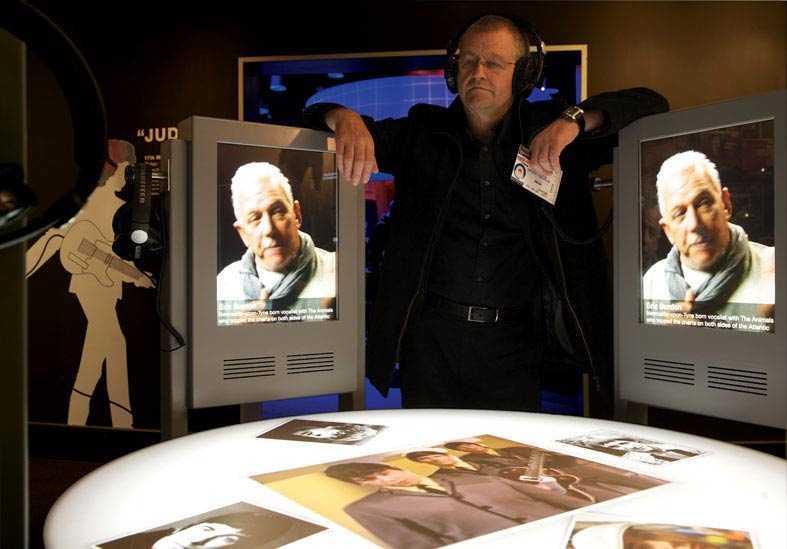
Sound
As a new departure Land are now creating sound for moving image, ‘Into The Light’ has already been acknowledged at several European Short Film Awards.
Click on any of the projects below to see more.
Into the Light
Completion: December 5, 2022
As a new departure Land are now creating sound for moving image, ‘Into The Light’ has already been acknowledged at several European Short Film Awards.